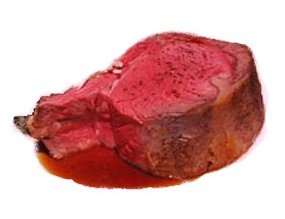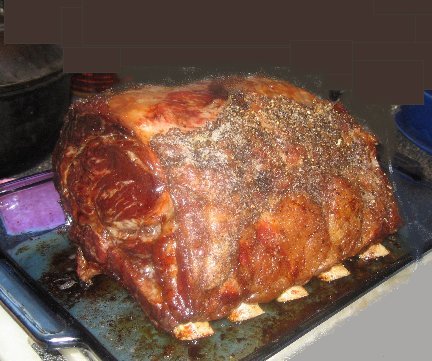Works in most Browsers
 Homepage
Sitemap
Site Search
Homepage
Sitemap
Site Search
Convert the recipe![]()
Works in most Browsers
USDA Choice is the grade that is found at most markets and butcher shops, but if you really want to splurge, go for Prime grade. Unfortunately it will be twice the price and have more fat, your cost will be much higher, so is the price worth it? Well it depends on how much you can afford and your taste! USDA Choice is an excellent grade of beef with slightly less marbling than Prime and this is what most restaurants use today except for high-end steak houses and some hotels.

The key to a good roast is to be sure you're getting a
Choice or Prime USDA graded roast, and or look for meats
that might be noted as Certified Angus or Sterling
Silver. Always buy it from a good source such as a
butcher shop or a specialty food market, as they
have access to the best Choice grade meats sold on
the wholesale market. Most supermarkets get what's
left after these purveyors take the best for
themselves. So now you know where you will buy it.
When there, ask the butcher trim the cap and some of
the excess fat, but leave a layer of fat to protect
and baste your roast as it cooks. A 1/4 to 1/2 inch
layer is a good amount; ask the butcher to tie the
roast as well. The true prime rib is known to
restaurants as the "#109"; this specification is a
roast-ready piece of meat that contains seven
ribs, 6th to the 12th. In slicing the cooked rib a
restaurant would normally give 14 slices or
portions: 7 with the bone and 7 without. Cost per
slice is a determining factor and a skilled chef can
even get 16 to 20 slices per roast---but the
customer gets less of a value for the price charged.
When choosing a prime rib roast for home, select at
least a three rib bone portion. Anything smaller is
hard to cook properly. A three-rib roast will weigh
in at about seven to eight and a half pounds and
feed about six people. Count on feeding two people
per rib, the on the bone and off the bone cut
described above. Beware---in cooking a prime rib
and other roasts, there is always a 20% shrinkage in
weight after cooking. For example, for a restaurant
roasting a 20 pound rib, after 3 1/2
hours of cooking, it will weigh in at 16 pounds!
A good digital instant-read meat thermometer is
essential to cooking to an exact doneness. It's the
only sure way to tell when your roast has achieved
a desirable temperature.
Allow the roast to sit out for up to one hour right
before roasting to take the chill out of it. It will
need seasoning and some preparation to get it into
the pan; you can count this in the hour's time.
First preheat your oven to 450 degrees and get your
roasting pan and other ingredients ready.
Rub, season, with ground black pepper, coarse salt
and some canola oil all over the roast, covering all
exposed meat and fat.
Place the roast in a sturdy roasting pan, bone-side
down.
No matter what size roast you have, you will first
start it in a pre-heated 450 degree oven for 15
minutes, then reduce the temperature to 350 degrees
for the balance of cooking time. Cooking times will
vary depending on size of the roast and desired
level of doneness. The following chart gives
approximate times to reach "rare" at various
sizes.
Cooking Time for rare 120-122°
3 Ribs, 7 to 8 lbs. 15 minutes at 450°, then 1 ¼ to
1 ½ hours at 350°
4 Ribs, 10 to 11 lbs. 15 minutes at 450°, then 1 ½
to 2 hours at 350°
5 Ribs, 13 to 15 lbs. 15 minutes at 450°, then 2 to
2 ½ hours at 350°
6 Ribs, 17 to 19 lbs. 15 minutes at 450° then, 2 ¾
to 3 hours at 350°
7 Ribs, 20-22 lbs. 15 minutes at 450° Then, 3 ¼ to 3
¾ hours at 350°
Turn the roast over after 1 hour and 15 minutes and
and then back to the bones on the bottom after 2 1/2
hours. Be careful as fat will be in the bottom of
the pan, it will be hot, and you don't want to spill
or splash any on you or the oven. Use a sturdy
kitchen fork and ask someone one to assist you in
this process---especially if you are roasting a full
22 pound size rib!
Using your meat thermometer, about a half hour
before the expected end of the roasting time, insert
it in the thickest and central part of the meat, not
touching the fat or bone. When the internal
temperature reaches 120-122°, pull it out of the
oven---if you want it rare. Let the roast sit for
twenty to thirty minutes. It will continue to cook
during this time, reaching a temperature of about
125°.

While the roast is resting, add 1 quart or more
mirepoix to the pan and fry/caramelize on medium-low
heat. Drain the fat, saving some for the popovers,
and deglaze the mirepoix and pan with beef broth or
stock to make the au jus. Strain the juices and
remove any fat and then keep the au jus warm.
Raifort (Horseradish) Sauce
About ¼ to ½ cup of prepared horseradish, drained of
the vinegar juices and rinsed under cold water,
mixed with two cups of béchamel sauce thinned with
heavy cream and seasoned with salt, ground white
pepper and a few grinds of fresh nutmeg.
Popovers
A traditional English side dish to Prime Rib is
Yorkshire Pudding, an egg and flour batter poured
into the roasting pan with the fat and then
baked in the oven. It comes out like a custardy, biscuity soufflé pancake. The American version of
this is individual Popovers, the same recipe but
they are crisper and almost soufflé looking and
shaped like a muffin.
Carving: see any number of videos on the Internet. Then use a long, very sharp knife to carve your roast! Serve with popovers, au jus and Raifort sauce.